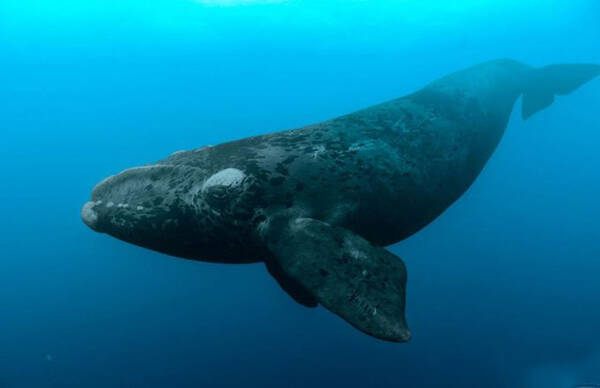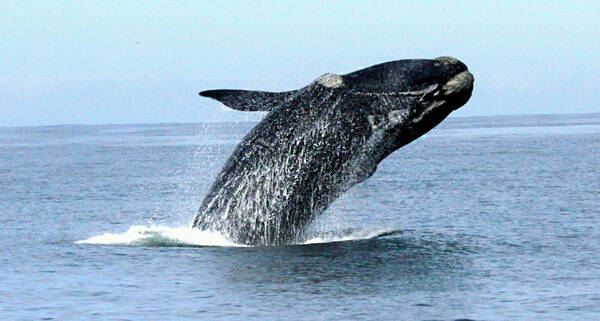Eubalaena australis
IUCN
LCBasic Information
Scientific classification
- name:Eubalaena australis
- Scientific Name:
- Outline:Cetacea
- Family:R.whale
Vital signs
- length:15-18m
- Weight:47-80 tons
- lifetime:Around 1980
Feature
The body is dark grey or black, with occasional spots on the abdomen.
Distribution and Habitat
Marine range: Southern right whales are distributed in the southern waters of the Southern Hemisphere.
Countries and regions: Antarctica, Argentina, Australia, Bouvet Island, Brazil, Chile, Falkland Islands (Malvinas), French Southern Territories (Kerguelen), Madagascar, Mozambique, Namibia, New Zealand, Peru, St. Helena, Ascension and Tristan da Cunha (Tristan da Cunha Island), South Africa, South Georgia Island and the South Sandwich Islands, Uruguay.
Appearance
The Southern Right Whale is 15-18 meters in length and weighs 47-80 tons. Like other right whales, the Southern Right Whale can be distinguished by the callous on its head, its broad back without a dorsal fin, and its long, arched mouth. Its body is dark gray or black, with occasional spots on its belly. The callouses on its skin appear white, not due to pigmentation, but rather to large colonies of whale lice. The Southern Right Whale has the largest testicles of any animal, weighing about 500 kilograms each. The Southern Right Whale is almost indistinguishable from the North Atlantic or North Pacific Right Whale in appearance, except for the slight difference in its head. The Southern Right Whale may have fewer callouses on its head than its Northern Hemisphere counterparts, but more callouses on its jaws.
Details
Southern right whale (scientific name: Eubalaena australis) is also known as Southern right whale in foreign languages. It has no subspecies. It was described by Desmoulins in 1822, and later classified as a genus of Eubalaena by Gray in 1864. The previous classification considered the Southern right whale to be a subspecies of the North Atlantic right whale (Eubalaena glacialis), but now it is considered to be two different species.

Southern right whales migrate to southern latitudes of the Southern Hemisphere during the summer months, where plankton populations are more abundant, and migrate northwards during the winter and spring. They mate within 24 hours at speeds of 2.7-4.2 km/h. In addition, southern right whales swim close to shore at speeds of up to 15 km/h (only for short distances), but are generally slower swimmers.
Southern right whales produce short, low-frequency moans and pulses. Southern right whales are also often heard striking, usually below and above the water's surface. However, the most common sound produced is a burp-like sound that is 1.4 seconds long on average and has a frequency below 500 Hz. Southern right whales also produce simple moans within a narrow frequency range, while complex moans vary in frequency and overtones. Other sounds produced by southern right whales are the slapping of their fins and tails as they roll on the surface of the water - often during mating and courtship.
In a common behavior of these whales, known as "erecting," they assume a vertical position and extend their suction cups into the air, often rocking back and forth for up to two minutes at a time. Initial studies suggested that the posture was used to feed on bottom-dwelling organisms, but it was later thought to be a resting posture or courtship stimulus. Southern right whales are also often seen feeding mid-air - turning around in mid-air and dropping their sides or backs into the water. This behavior may dislodge parasites from their surfaces, but is also a display mechanism during mating.

Southern right whales use their long, numerous baleen plates to feed on small plankton, including pelagic larval crustaceans and copepods. They are commonly observed using one of two feeding techniques. The first is surface feeding, when whales selectively swim through densely populated plankton slicks with their mouths open and baleen plates exposed. The other method is underwater, probably in highly dense plankton populations.
Southern right whales are polyandrous, with up to seven males for every female. Courtship and intercourse are described as gentle and graceful (Cummings 1985). The duration of courtship varies, but usually lasts an hour or two, after which the male and female separate from each other. Males copulate with the same female without hostility, which is highly unusual among mammals. It is thought that this passive behavior suggests intrauterine sperm competition. Southern right whales reach reproductive maturity at about 10 years of age. Reproduction occurs approximately every three years, with females having a gestation period of 11-12 months and giving birth to one calf each time, with a lactation period lasting 4-6 months. The calf weighs 1000-1500 kg at birth, is 5-6 meters long, and grows 3 cm per day.
The southern right whales in South America, southern Africa and Australia rarely mate with each other, because female southern right whales are very dependent on the habitat for raising and giving birth, and they will rely on instinct to return to the calves.

Conservative estimates put the total number of whales caught between 1770 and 1900 at around 150,000, with 48,000-60,000 caught in the 1830s alone. By the start of the 20th century, the species was already extremely rare, and the total number of whales caught thereafter, until 1935 when whales were legally protected, was just 1,000. The population was estimated to be over 70,000 in 1770, but had declined to about 300 by the 1920s. The species began to recover in 1935 after being protected, but in the 1960s, the Soviet whaling fleet illegally seized more than 3,000 ships (Tormosov et al., 1998), and it is estimated that illegal fishing by the Soviet Union in the 1960s eliminated more than half of the remaining population and delayed recovery (IWC 2001, 2013).
Because the ocean is so vast, it is difficult to get an accurate number of southern right whales. According to data presented at a workshop held by the International Whaling Commission in Cape Town in March 1998, it is estimated that there are about 7,000 southern right whales. The data were collected by researchers studying adult female right whales in three locations (Argentina, South Africa and Australia) in the 1990s, and then extrapolated to other unstudied areas using the ratio of males to females and the ratio of adults to calves, resulting in an estimated 7,000 southern right whales in 1999. In Brazil, more than 300 southern right whales have been documented through photographic identification (using their distinctive head callouses) by the Brazilian Right Whale Project, which is jointly supported by Petrobras and the International Wildlife Coalition. Santa Catarina is a breeding and calving center for right whales from June to November, and females are also known to give birth in Patagonia, Argentina.
By 2009, the Southern Right Whale population was estimated to have reached 13,600 individuals and is still growing strongly (IWC, 2013). In recent years, there is evidence of a leveling off in the western South Atlantic (Crespo et al., 2017) and western Australia (Bannister et al., 2016; IWC, 2018). Since 2015, the Southeast Atlantic population (South Africa and Namibia) appears to have declined sharply for unknown reasons (Findlay et al., 2017).
Listed on the IUCN Red List of Threatened Species (IUCN 2017 ver 3.1) - Least Concern (LC).
Listed in Appendix I of the Convention on International Trade in Endangered Species of Wild Fauna and Flora (CITES).
Listed in Appendix I of the Convention on the Conservation of Migratory Species of Wild Animals (CMS).
Protect wildlife and eliminate game.
Maintaining ecological balance is everyone's responsibility!








